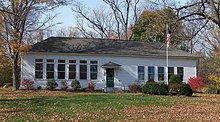This is an old revision of this page, as edited by 68.229.74.16 (talk) at 12:27, 24 August 2011 (→Significant properties: corrected grammar). The present address (URL) is a permanent link to this revision, which may differ significantly from the current revision.
Revision as of 12:27, 24 August 2011 by 68.229.74.16 (talk) (→Significant properties: corrected grammar)(diff) ← Previous revision | Latest revision (diff) | Newer revision → (diff) United States historic place| Marion Historic District | |
| U.S. National Register of Historic Places | |
| U.S. Historic district | |
 Lester Beecher House (1166 Marion) Lester Beecher House (1166 Marion) | |
| Location | Along Marion Ave. and the Meriden-Waterbury Turnpike, Cheshire (New Haven County) and Southington (Hartford County), Connecticut |
|---|---|
| Architect | Multiple |
| Architectural style | Greek Revival, Italianate, Federal |
| NRHP reference No. | 88001423 |
| Added to NRHP | December 21, 1988 |
The Marion Historic District is a historic district in the Marion section of Southington in Hartford County, Connecticut. The district also includes two houses on the Cheshire side of the town line between Southington and the town of Cheshire in New Haven County. The historic district was listed on the National Register of Historic Places in 1988. Architectural styles in the district include Greek Revival, Italianate and Federal.

It includes the Asa Barnes Tavern (also known as the Levi B. Frost House) and the Federal style Barnes-Frost House, which are separately listed on the National Register.
Rochambeau visit
Marion is the site of an encampment by the French general, Jean-Baptiste Donatien de Vimeur, comte de Rochambeau and his troops during the American Revolutionary War. In June 1781, the French troops under Rochambeau's command left Farmington and marched 13 miles to their eighth camp through Connecticut, near Asa Barnes's Tavern in the Marion section of Southington. They camped there for four days. Rochambeau and his officers took shelter in the tavern, and the troops set up camp on a hill on the other side of the road. The area of the encampment has since become known as French Hill, and a marker on the east side of Marion Avenue commemorates the French campsite. According to Rev. Timlow's Sketches of Southington (1875), "Landlord Barnes gave a ball at his tavern, at which a large number of the young women of the vicinity were present; and they esteemed it something of an honor to have had a 'cotillion' with the polite foreigner." The celebrations—infused with spirits provided by Landlord Barnes—spanned the four nights they were in Southington. Rochambeau revisited Asa Barnes's Tavern again on the return march on October 27, 1782. According to Timlow's Ecclesiastical and Other Sketches of Southington, Conn., coins, buttons and other things were picked up in the vicinity many years after the two encampments. The Asa Barnes Tavern is now a private residence very near the camp site at 1089 Marion Avenue.
Significant properties
The historic district includes 34 primary contributing properties. These include:
- Asa Barnes Tavern, 1089 Marion Avenue, a Greek Revival/Colonial structure that is itself individually listed on the National Register of Historic Places.
- Miles Upson House, 1316 Marion Avenue, a one-story gable front Colonial example, "perhaps the oldest house in the district to retain its original form" (See photo #3 in photos accompanying NRHP nomination)
- The Lester Beecher House, 1166 Marion Avenue, has been termed a Queen Anne style house for its irregular massing and 3 story tower.
Historic district designation

The Marion Historic District was listed on the National Register of Historic Places on December 21, 1988, as a result of a nomination submitted by the Connecticut Historical Commission in July 1988. The nomination described the district as being architecturally significant "as a collection of well-preserved buildings dating from the 18th, 19th, and early 20th centuries which together reflect the historical development of the Marion community of Southington." Contributing properties in the district were described as representing three distinct periods on Marion's history: "early agricultural development" from about 1770 to 1842, "19th-century industrial activity and community growth" from 1842 to 1900, and "early suburban growth" from 1914 to 1938.
The Marion Historic District does not have local historic district designation. The town of Southington has not established local historic districts and the portion of the district that is located in the town of Cheshire is not included in either of that town's two local historic districts.
See also
References
- ^ "National Register Information System". National Register of Historic Places. National Park Service. March 13, 2009.
- ^ Janice L. Elliott, David F. Ransom, and John Herzan (January 26, 1988). "National Register of Historic Places Inventory-Nomination: Marion Historic District" (PDF). National Park Service.
{{cite web}}: CS1 maint: multiple names: authors list (link) and Accompanying 19 photos, from 1987 (see photo captions page2 19-20 of text document) - L.C. Kopec, Southington, (Arcadia, 2007)
- F.S. Marcy Crofut, Guide to the history and the historic sites of Connecticut, (Yale University Press, 1937)
- H.R. Timlow, Ecclesiastical and Other Sketches of Southington, Conn, (1875)
- David F. Ransom (1987), National Register Nomination Form: Levi B. Frost House (Barnes Tavern), Connecticut Historical Commission
- Connecticut Trust for Historic Preservation, Local Historic Districts List, accessed October 31, 2010
- Cheshire Historic District Commission (website), accessed October 31, 2010
- Brochure of the Historic District Commission of Cheshire, Connecticut: Cheshire Historic Districts: South Brooksvale Road, and, Cornwall Avenue - Town Center, undated, accessed at Cheshire Historical Society website on October 31, 2010
| U.S. National Register of Historic Places | |
|---|---|
| Topics | |
| Lists by state |
|
| Lists by insular areas | |
| Lists by associated state | |
| Other areas | |
| Related | |